New 2022 Population Estimates Show Most Large Cities and Towns Grew Faster or Lost People at Slower
May 19, 2023

Many cities at the core of large U.S. metropolitan areas were no longer among the largest population losers in 2022, reversing a pattern seen during the first full year of the COVID-19 pandemic in 2021.
Today’s release of Vintage 2022 population estimates for cities and towns shows that the magnitude of population loss for some large cities decreased between 2021 and 2022.
While almost half of the fastest-declining cities had populations of 100,000 or more in 2021, only three had populations of 100,000 or more a year later.
About half of the nation’s fastest-growing cities just over a year into the pandemic (July 1, 2021) remained among the top-15 gainers one year later (July 1, 2022), growing at an even faster rate.
Mix of Cities Experiencing Decline Changed
The 15 fastest-declining cities from 2021 to 2022 and 2020 to 2021 were different, with major cities like Boston, Washington, D.C. and, most notably, San Francisco falling off the list.
While almost half of the fastest-declining cities had populations of 100,000 or more in 2021, only three had populations of 100,000 or more a year later. Two cities (Jackson, Mississippi, and New Orleans, Louisiana) were negatively impacted by Hurricane Ida (Tables 1 and 2).
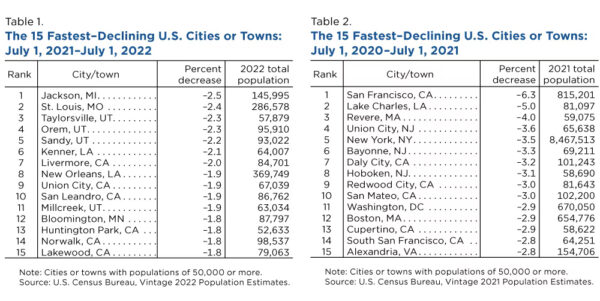
Plus, the rate of population losses from 2021 to 2022 (Table 1) were more in line with pre-pandemic patterns (Table 3).
For instance, Jackson, Mississippi, with the largest percentage (2.5%) drop during that period, would have made the list of fastest-declining cities in 2019 but not in 2021 (Tables 1, 2 and 3).
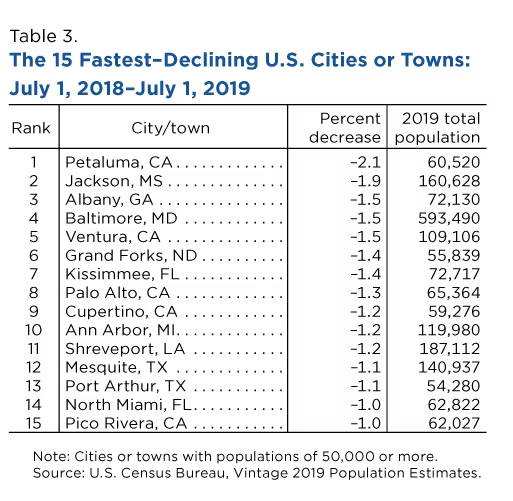
Which Cities Gained Population?
Fort Worth, Texas, the third largest-gaining city since 2018, ranked first in 2022 with a numeric increase of 19,170 from 2021.
In addition, San Antonio and Georgetown, Texas; Phoenix, Arizona; and Port St. Lucie and Cape Coral, Florida, showed notably larger increases in 2022 than in 2021 – possible signs of population rebound.
From 2021 to 2022, the total population increase for the nation’s 15 largest-gaining cities was just over 197,800, compared to a collective gain of about 129,000 people from the 2020 to 2021 period which included the first full year of the pandemic (Tables 4 and 5).
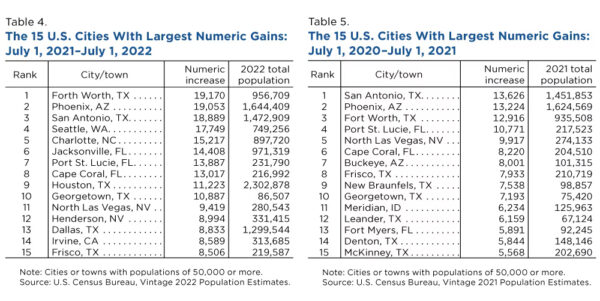
The total number of people added to the top-gaining 15 cities from 2021 to 2022 also outpaced their total pre-pandemic population increase (187,100) from 2018 to 2019 (Table 6).

Population Losses
New York City continued to exhibit the largest numeric decline, losing 123,104 people from 2021 to 2022. But this was nearly 60% less than its 2020-2021 population loss of 305,465.
Declines also slowed in other large cities that had experienced significant population losses, including Boston, Chicago, Los Angeles, Philadelphia, Portland and San Jose, (Tables 7 and 8)
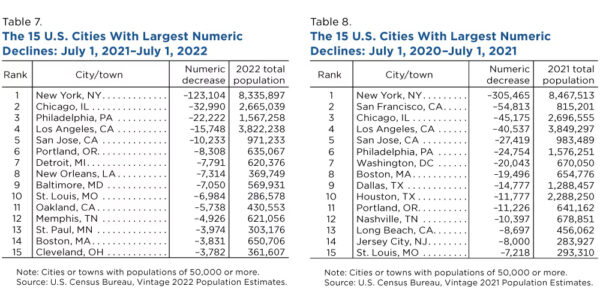
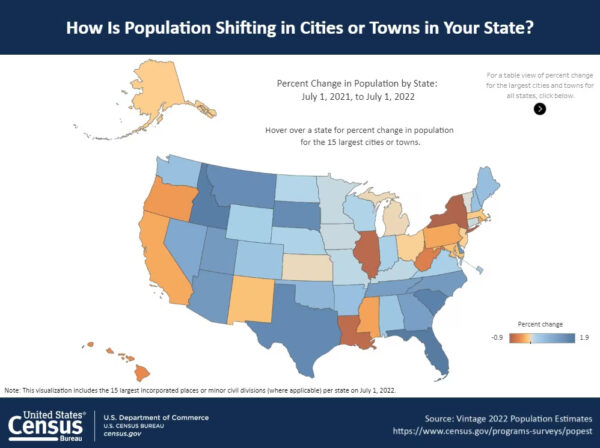
How We Calculate Estimates
The annual population and housing unit estimates for states, counties, cities and towns are developed using various administrative data sources such as birth and death certificates and tax return statistics on people who changed residences.
The decennial census serves as a starting point for each decade of subcounty population estimates.
Cities and towns are more likely than larger geographies to annex land or disincorporate. We apply these types of legal boundary changes to the decennial census to create an updated base for population and housing units.
Such geographic updates are made annually, so each new time series of estimates we produce begins from a newly updated geographic base. This “estimates base” created from the census is essential for accurately distributing the population.
More details on city and town populations are available in the subcounty methodology statement.
About Authors
- Amel Toukabri is chief of the Local Government Estimates and Migration Processing Branch in the Census Bureau’s Population Division.
- Crystal Delbé is a survey statistician in the Population Division.





























